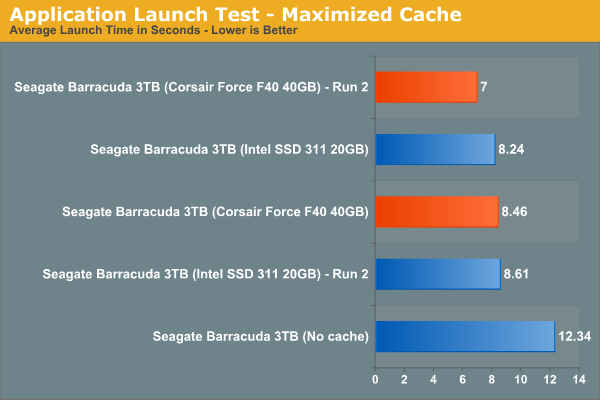Z68 SSD Caching with Corsair's F40 SandForce SSD
by Anand Lal Shimpi on May 13, 2011 3:06 AM ESTImpact of SSD Size on Cache Performance
A cache's performance is determined by how well the caching algorithm matches the workload, how well the cache size accommodates the workload and how quickly you can access the cache. So far we've demonstrated that Corsair's F40 can perform anywhere from noticeably worse to a bit faster than Intel's SSD 311 as a cache. I wanted to see if I could demonstrate the capacity advantage alone offered by the F40. To illustrate this I performed 11 tasks in a row composed of application launches, game launches and level loads. After running through all 11 tasks once, I rebooted and ran through them again. I then rebooted again and ran through the 11 tasks one more time, for a total of two cached runs per SSD cache. In theory the larger cache should be able to maintain application launch performance between runs:
| Application Launch Performance - Seagate Barracuda 3TB - Time in Seconds | |||||||
| Application (Listed in Launch Order) | First Run | Intel SSD 311 - Run 1 | Intel SSD 311 - Run 2 | Corsair Force F40 - Run 1 | Corsair Force F40 - Run 2 | ||
| Portal 2 | 12.0 | 9.6 | 12.1 | 9.3 | 9.3 | ||
| Portal 2 (Level Load) | 17.1 | 14.8 | 15.4 | 14.1 | 14.2 | ||
| WoW | 5.3 | 4.3 | 5.8 | 4.7 | 4.4 | ||
| WoW (Level Load) | 11.9 | 11.7 | 6.2 | 5.2 | 5.2 | ||
| Starcraft 2 | 15.3 | 11.9 | 10.2 | 7.9 | 8.0 | ||
| Starcraft 2 (Level Load) | 23.3 | 17.6 | 14.1 | 14.4 | 15.1 | ||
| Photoshop CS5.5 | 7.1 | 3.5 | 6.5 | 6.3 | 3.2 | ||
| After Effects CS5.5 | 19.3 | 6.6 | 11.6 | 12.7 | 6.7 | ||
| Dreamweaver CS5.5 | 8.0 | 4.7 | 6.2 | 6.2 | 4.5 | ||
| Illustrator CS5.5 | 6.1 | 2.9 | 3.7 | 5.3 | 3.1 | ||
| Premier Pro CS5.5 | 10.4 | 3.2 | 3.1 | 6.9 | 3.2 | ||

On the first run both the Corsair F40 and Intel SSD 311 manage to perform very similarly. On the second run however, many of the applications load slower on the SSD 311 as some data has apparently been evicted from the cache. The 40GB Corsair F40 doesn't suffer the same fate as it has much more data for storage and as a result the second run through shows continued performance improvement.










81 Comments
View All Comments
Dribble - Friday, May 13, 2011 - link
The reason being they are so common they are cheap. In the UK you can't get that 20GB Intel SSD yet, and while you could get the 40GB force (or vertex 2) the cost difference is very small - like I did you might as well get the 60GB vertex 2. I suspect a few others will do the same thing.Hence it would seem a good test.
The other thing I'd like to know is if you can buy a large capacity SSD (e.g. 240GB vertex 3) and then partition it giving 180GB to use as a boot drive, and the other 60GB to cache your monster games disk.
10Goto10 - Friday, May 13, 2011 - link
Or a 6Gb Sata Vertex3 240 GB, it should have enough IO, throughput and space to maintain both os and cache.Ryan Smith - Friday, May 13, 2011 - link
Yes, you can partition SSDs. In fact we've thrown around the exact same idea.10Goto10 - Friday, May 13, 2011 - link
According to the test hardware spec, the test is run on H67 not Z68, copy paste ;) ??mschira - Friday, May 13, 2011 - link
Would it be possible to get some SSD caching on a thinkpad t-series? they not only have a normal hard drive slot but they also have a miniPci slot for which they explicetly support small SSD to mount there...now having SSD caching would be great...
M.
DanNeely - Friday, May 13, 2011 - link
First page, the table lists an h67 mobo for the test, not a Z68jdavenport608 - Friday, May 13, 2011 - link
Both your articles about Z68 mention that SSD caching can be used in front of a RAID array. Do you plan on doing an article that describes the benefits or value of using a SSD cache in conjunction with different RAID arrays?weh69 - Friday, May 13, 2011 - link
I'd love to see results for a 60GB SSD as cache in front of a dual 2TB WD black RAID-1 array as the system drive.hechacker1 - Friday, May 13, 2011 - link
If that is possible, I would really like to see that too.Especially for a raid-5 config. Since write performance is limited so much by parity writes, having a cache could really help (on maximum mode).
kepstin - Friday, May 13, 2011 - link
This Intel SSD caching feature is a bit disappointing in one way.It's obvious that the caching work is done completely in software - in the Windows chipset driver, the same way as the motherboard RAID features work. There probably is some BIOS support required to boot off it though.
There's no technical reason why the same technology couldn't be used on other chipsets - it's just that Intel's decided to artificially limit it to the Z68...
I wouldn't be surprised if third-party tools and a generic Linux driver that can do the same thing on any chipset start showing up later this year.